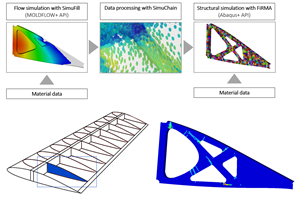February Editorial
Composite materials are a hot topic in the automotive industry, and this issue of Composites Technology offers a lot of automotive coverage. Several global economic realities bode well for increased use of composite materials in the automotive sector. The first is that, despite the recent U.S. auto industry slide,
Composite materials are a hot topic in the automotive industry, and this issue of Composites Technology offers a lot of automotive coverage.
Several global economic realities bode well for increased use of composite materials in the automotive sector. The first is that, despite the recent U.S. auto industry slide, auto sales have never been better. Global auto revenue reached $154.5 billion in 2005, up more than 5 percent from 2004 — and continued growth is predicted.
Second is the price of oil. While the high price of a gallon of gas foretells hard times for American automakers who have made their greatest profits on gas-guzzling SUVs, it also means, more importantly, that everything that moves needs to be lightweighted, in the U.S. and elsewhere. That puts a premium on strong, stiff, lightweight materials like composites.
Third, demand for metals has gone up dramatically in developing countries, driving up the price of steel and aluminum as well. As recently as September 2003, a ton of hot-rolled steel sold for just $290, but by September 2004, steel had hit $756/ton, a one-year leap of 161 percent. While steel is expected to moderate to about $600/ton in 2006, prices will not soon return to 2003 levels. Meanwhile, aluminum prices are expected to rise for the fourth straight year. Aluminum averaged $1,895/ton on the London Metal Exchange in 2005, and is likely to increase 11 percent this year, as demand (+6.7 percent) outpaces production gains (+4.7 percent). Production capacities for steel and aluminum will remain tight for the next few years. But demand will outdistance capacity for the next decade, at least, even as new supplies come online worldwide, in part, because of growth in Asia. China alone — now the largest consumer — already uses 30 percent of worldwide capacity.
These factors will help level the playing field for composites in the auto industry, where the big driver in material selection has always been cost — despite the fact that composite materials offer much greater stiffness- and strength-to-weight. The once wide cost gap between composites and metals is narrowing fast.
As our Detroit Auto Show coverage (p. 20) indicates, sheet molding compound, after a period of difficulty with painting issues, are rebounding and finding applications in a wider range of vehicles than ever. As Europe presses its environmental mandates, automakers are pursuing natural fiber-reinforced thermoplastic applications. Our investigation of the bio-fiber market (p. 28) reveals a growth rate of 10 to 15 percent per year for natural fibers since the turn of the century, as cost-effective and recyclable natural fiber/thermoplastic combinations begin to replace glass fiber/thermosets in noncosmetic applications. And even pricey carbon fiber is beginning to creep down from Formula 1 and supercar niches into the more widely produced GT car segment. A good example is the all-carbon "space frame" chassis in our "Engineering Insights" feature, on p. 44.
New Automotive Design Guide coming in 2006
Ìý
Also of note: In September, Ray Publishing is going to publish an updated version of its Automotive Composites Design Guide. The first edition was published in 1997. Much has changed since then, and we feel the time is right. If your company is interested in participating, please contact me or our technical editor, Sara Black.
Finally, we're proud to announce the establishment of our new European Sales Office. Sian Raynor of Plus Integrated Marketing, a veteran of the composites industry (most recently as the marketing manager for SP Systems), takes responsibility for our European advertising accounts this month. You can reach Sian via telephone at +44 198 3240 475 and via e-mail at sian@compositesworld.com. She will join us at the JEC show in Paris. See you there.
Related Content
Composite materials, design enable challenging Corvette exterior components
General Motors and partners Premix-Hadlock and Albar cite creative engineering and a move toward pigmented sheet molding compound (SMC) to produce cosmetic components that met strict thermal requirements.
Read MoreSMC composites progress BinC solar electric vehicles
In an interview with one of Aptera’s co-founders, CW sheds light on the inspiration behind the crowd-funded solar electric vehicle, its body in carbon (BinC) and how composite materials are playing a role in its design.
Read MoreIDI Composites opens new global headquarters, manufacturing and technology center
The Noblesville, Indiana, facility includes SMC and BMC manufacturing, an R&D center and the company’s corporate headquarters.
Read MoreImproving carbon fiber SMC simulation for aerospace parts
Simutence and Engenuity demonstrate a virtual process chain enabling evaluation of process-induced fiber orientations for improved structural simulation and failure load prediction of a composite wing rib.
Read MoreRead Next
Assembling the Multifunctional Fuselage Demonstrator: The final welds
Building the all-thermoplastic composite fuselage demonstrator comes to an end with continuous ultrasonic welding of the RH longitudinal fuselage joint and resistance welding for coupling of the fuselage frames across the upper and lower halves.
Read MoreComposites end markets: New space (2025)
Composite materials — with their unmatched strength-to-weight ratio, durability in extreme environments and design versatility — are at the heart of innovations in satellites, propulsion systems and lunar exploration vehicles, propelling the space economy toward a $1.8 trillion future.
Read More“Structured air” TPS safeguards composite structures
Powered by an 85% air/15% pure polyimide aerogel, Blueshift’s novel material system protects structures during transient thermal events from -200°C to beyond 2400°C for rockets, battery boxes and more.
Read More








